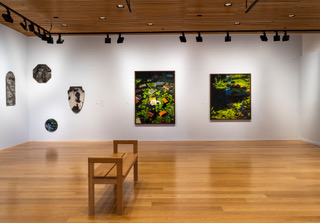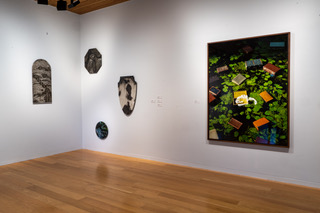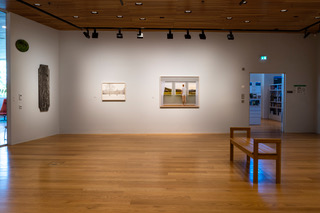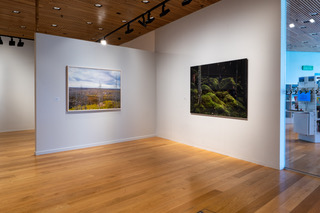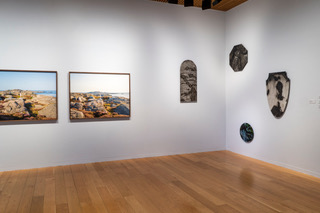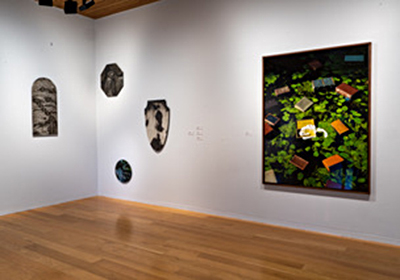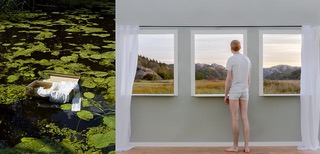There is a particular part of Maria Friberg’s and Peter Stridsberg’s exhibition Blicka that I want to start with, even if it concerns their methods rather than the artworks. After all, the end result and the method are connected in several ways. A persistent myth in the artworld is the idea of the lone genius and that truly great artists are introspective, and will, regardless of other artists or the world around them – if you will – do their own thing. Aside from not wanting to be interrupted in the creative process, this is also about guarding one’s methods and ideas and keep them secret. Another way of looking at things – which has influenced this exhibition – is to see the value of sharing and cooperating. In that regard, Friberg’s and Stridsberg’s method is similar to the collegial culture found among researchers. An open and critical conversation forms the basis for new knowledge and perspectives. Another suitable comparison is how musicians in a band drive the creative process forward, and the performance is dependent on every bandmember paying attention, and contributing to, the whole.
For several years, Maria Friberg and Peter Stridsberg have had a collegial exchange based on mutual trust and the idea that sharing thoughts and experiences strengthens them. It is an exchange that built on a shared interest and the fact that they come from two different generations adds to their dynamic. This form of creative collaboration has always been central to Maria as an artist. She first sought out constellations where the members were inspired by, and learned from, each other in the late ‘90s. She has had close one-on-one collaborations, but also worked on larger production teams whose different skills have been vital to realize the projects. Maria’s vast experience of exploring staged photography was the main reason why Peter sought her out. Aside from containing a performative element, the events, objects or people in Maria’s and Peter’s photos often appear to be on a stage. Even if the scenic imagery should not be taken too literally, the theatrical aspect creates a feeling that what is pictured takes place in a different time or space than our everyday world. Both of their work contains a deep fascination with nature and mankind’s role and place in the natural world – a relationship that has grown ever more problematic. They also share a photographic imagery inspired by expressions and moods found in traditional painting. In Maria’s case there is a strong kinship with the pre-Raphaelite movement and turn-of-the-century symbolism, which is expressed in part through the rich, gemstone shimmering colors – especially the chlorophyll green shades – and in the subjects. The forest is populated by children who, like fairytale creatures, seem closer to nature than to human beings. At the same time, they seem to come from someplace completely different, having magically materialized in the forest, and their demanding presence states that their future – and the future of generations to come – is at stake. In another suite called Handed we see scattered suitcases that speak of breaking up and seeking refuge, which will increasingly shape people’s lives as the Earth’s temperature rises and more areas become uninhabitable, but also because of ongoing wars, that threaten to spread as the ice melts and the deserts grow.
For Peter, it is more about a combination of romanticisms depicting of the sublime and the more concrete study of light and landscape found in en plein air painting, giving the images a completely different expression and tone. The figure standing alone in the picture gazing out is not standing in a enveloping forest, but in an open rocky coastal landscape, where the sky and the looming horizon creates air and space. Every image in the suite Forecast Diaries is accompanied by an excerpt from the marine and coastal weather forecast, which is broadcast every day on Sveriges Radio. The factual listing of locations at sea along Sweden’s long coastline – along with the meteorological observations and prognoses – becomes a pragmatic poetry that seeps into the images:
In the Gulf of Bothnia and the Baltic Sea intermittent rain or showers with moderate to reduced visibility. Otherwise mostly clear visibility. Gale warning issued for Skagerrak, the south and southeast Baltic Sea, and the Gulf of Finland. Forecast for tomorrow morning. Skagerrak, Kattegatt western wind circa 8–13 meters per second, on eastern Skagerrak up to gale 15. Somewhat declining winds during the night.
The dynamic between pictures and words is a recurring feature in Peter’s work, the titles often working as an extension of the piece itself. One image depicting the devastation and regrowth after a wildfire, for example, can be called: Tändsticksskogens sköra minne står inför våra ofiltrerade blickar (“The fragile memory of the matchstick wood stands before our unfiltered gaze”). Among the scores of burnt tree trunks a lone person stands – here as in the other pictures a vicarious onlooker – trying to survey and comprehend what has happened.
In the meeting between the image summoned by the title and the photograph itself, something bigger than the sum of the two parts emerges. Interestingly, this expansion happens between
Maria Friberg’s and Peter Stridsberg’s works as well. When presented together, both their similarities and differences are emphasized, while something bigger than what their respective artistry contains is generated.
Niclas Östlind, Ph.D. senior lecturer of photography at HDK-Valand From Swedish to English by Natalia Frostkrans.
Väven, Umeå Konsthalls Website
